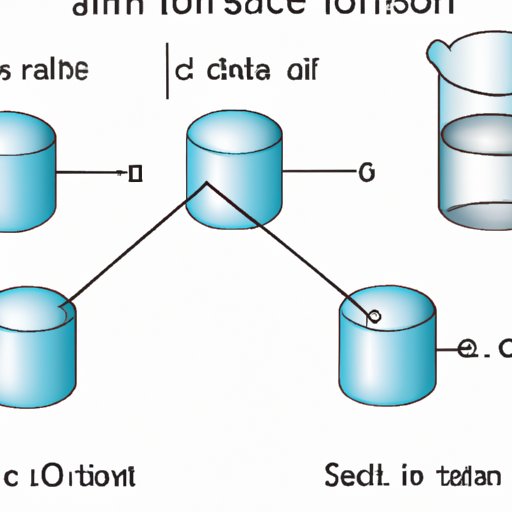Introduction
When you add salt to a glass of water, you may notice that it disappears almost immediately, leaving no trace behind. This process of dissolving has been studied and understood for centuries, yet it remains a fascinating and relevant topic in our daily lives. In this article, we will explore the science behind why salt dissolves in water and the practical implications of this everyday phenomenon.
From a Chemical Perspective
Salt is made up of positively charged sodium ions and negatively charged chloride ions. When salt is added to water, it begins to dissolve because the polar water molecules are attracted to the charged ions in the salt. Water molecules have a partial negative charge near their oxygen atoms and a partial positive charge near their hydrogen atoms, which is why they’re attracted to the sodium and chloride ions.
Several factors influence how easily salt will dissolve in water, including the temperature of the water and the amount of salt added. When salt dissolves, it breaks apart into individual ions. In water that’s near room temperature, several salt crystals dissolve within a minute or two. If the water is hot, it can dissolve even more salt – and at a faster rate. This is due to the molecules in hot water moving at a faster speed and colliding with the salt more frequently, causing it to dissolve more quickly.
Scientists have conducted experiments on salt dissolving in water to better understand these principles. These experiments involve measuring the rate of dissolution under different conditions, such as temperature and the concentration of salt in the water.
Practical Implications
The ability of salt to dissolve in water has numerous practical applications in our daily lives. We use salt in our food for flavoring and preservation. Salt is also an important component in many manufacturing processes such as making soap, dyes, and paper. In addition, salt is commonly used for cleaning and de-icing roads in the winter.
One interesting fact is that the amount of salt that can dissolve in water varies depending on the temperature of the water. More salt can dissolve in hot water than in cold water. For example, at room temperature, you can dissolve about 35 grams of salt in 100 milliliters of water. But in boiling water, you can dissolve about 39 grams of salt in 100 milliliters of water.
Historical Perspective
The ability of salt to preserve food has been known for thousands of years. Early civilizations such as the Greeks and Romans used salt to preserve meat and fish. In ancient times, salt was also used as a currency and a form of payment. By the Middle Ages, it was used as a food preservative across Europe, making it a valuable commodity.
Scientists in the 17th century began to study the properties of salt and its ability to dissolve in water. Antoine Lavoisier, a French chemist, was one of the first to study the chemical composition of salt and investigate the process of dissolution in water.
Environmental Impact
The dissolution of salt in water can have significant environmental consequences. One example is the runoff from roads in the winter, which contains salt and other chemicals used for de-icing. This runoff can pollute natural aquatic systems and harm aquatic life. Studies have shown that high concentrations of salt in water can interfere with reproduction in some fish species and reduce the diversity of aquatic plant life.
Furthermore, the use of salt in agriculture can have negative effects on soil fertility and quality. The continued use of salt for de-icing and other purposes also has economic impacts, as the cost of salt and related maintenance can be substantial.
A Day In The Life
Imagine you are making a pot of soup and need to add salt to the recipe. You open the container and measure out a teaspoon of salt. You carefully add the salt to the pot of soup and stir it in. Within seconds, the salt seems to have disappeared. What has happened? The salt has dissolved in the water that’s in the soup. This happens because the water molecules are attracted to the positively and negatively charged ions in the salt.
This simple example illustrates how salt dissolves in water and why it is such an important phenomenon in our daily lives. Whether we are cooking, cleaning, or de-icing roads, the ability of salt to dissolve in water is essential for these activities to be effective.
Conclusion
The ability of salt to dissolve in water is an everyday phenomenon that has fascinated scientists for centuries. Its scientific principles have been studied and understood, and its practical applications are numerous. However, it is important to be aware of the potential environmental and economic impacts of the dissolution of salt in water, particularly in the use of de-icing roads. By understanding the science behind salt dissolving in water, we can use this knowledge to make informed decisions in our daily lives.
